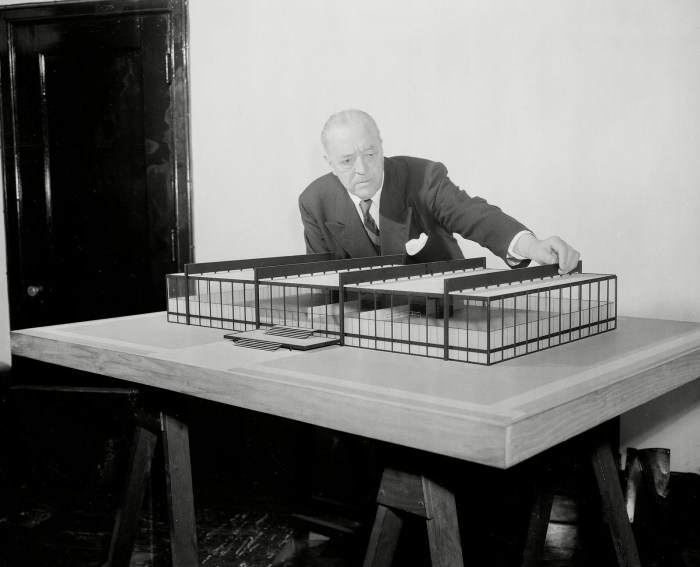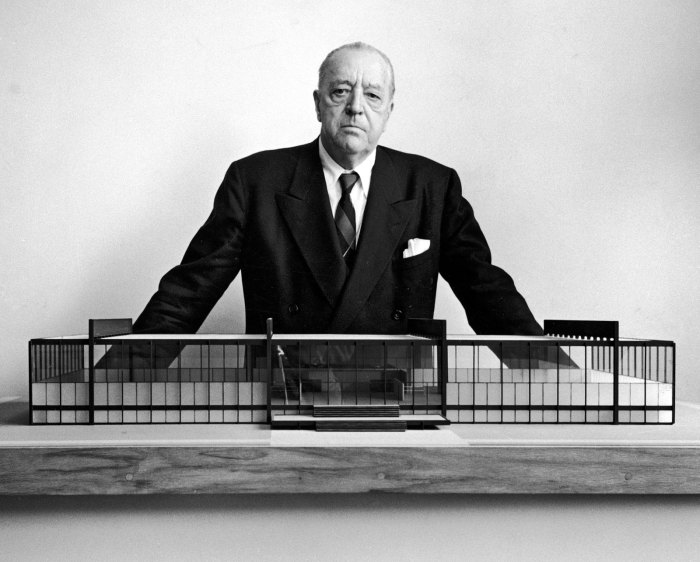Exploring the Legacy of Ludwig Mies van der Rohe
Embark on a journey through the life and works of Ludwig Mies van der Rohe, a pioneering figure in the world of architecture whose influence continues to resonate today.
Delve into his background, design philosophy, and iconic projects to uncover the essence of his enduring legacy.
Introduction to Ludwig Mies van der Rohe
Ludwig Mies van der Rohe, born on March 27, 1886, in Aachen, Germany, was a pioneering architect known for his modernist designs and minimalist approach to architecture. He began his career working in his father's stonemasonry business before eventually studying architecture at the Bauhaus school in Weimar.
Mies van der Rohe's early life experiences and training greatly influenced his later work and design principles.
Significant Contributions
- Developed the concept of "less is more," focusing on simplicity, clean lines, and the use of industrial materials.
- Pioneered the use of open floor plans and large, uninterrupted spaces in his buildings.
- Designed iconic structures such as the Barcelona Pavilion and the Seagram Building in New York City.
- Emphasized the importance of the relationship between architecture, nature, and the surrounding environment.
Design Philosophy and Principles
Mies van der Rohe believed in the motto "God is in the details," emphasizing the precision and clarity of design in every aspect of a building. His architectural philosophy revolved around the idea of creating spaces that were functional, efficient, and aesthetically pleasing.
He often used steel and glass to create open, airy structures that blurred the lines between interior and exterior spaces. Mies van der Rohe's work continues to influence architects and designers around the world, setting the standard for modernist architecture.
Architectural Style and Innovations
Ludwig Mies van der Rohe was known for his minimalist architectural style that emphasized open spaces, clean lines, and the use of modern materials.
Architectural Style
- Van der Rohe's style was characterized by the use of steel and glass to create sleek, geometric structures.
- He believed in the principle of "less is more", focusing on simplicity and functionality in his designs.
- His buildings often featured an open floor plan with minimal interior walls, allowing for a sense of continuity and spaciousness.
Use of Materials and Technology
Mies van der Rohe was a pioneer in using innovative materials and technology in his designs.
- He utilized steel frames and glass curtain walls to create a sense of transparency and lightness in his buildings.
- His designs often incorporated industrial materials like chrome, steel, and concrete for a modern aesthetic.
- Van der Rohe's use of advanced construction techniques allowed for large, open interior spaces with minimal structural support.
Comparison to Other Architects
When compared to other prominent architects of his time, such as Le Corbusier and Frank Lloyd Wright, Mies van der Rohe stood out for his strict adherence to minimalist principles and his focus on the expression of structure.
- Le Corbusier, known for his use of concrete and bold forms, had a more sculptural approach to architecture compared to Mies van der Rohe's emphasis on simplicity.
- Frank Lloyd Wright, on the other hand, favored organic architecture that integrated buildings with their natural surroundings, a stark contrast to Mies van der Rohe's urban and industrial aesthetic.
- Despite these differences, all three architects made significant contributions to the modernist movement and continue to influence architectural design to this day.
Iconic Projects
Ludwig Mies van der Rohe is renowned for several iconic projects that have left a lasting impact on modern architecture. Let's delve into some of his most famous works and their influence on contemporary architects.
Seagram Building, New York City
The Seagram Building, completed in 1958, is considered one of Mies van der Rohe's masterpieces. Its sleek, minimalist design and innovative use of materials like bronze and tinted glass set a new standard for skyscraper architecture. The building's emphasis on clean lines and open spaces has inspired countless architects and continues to be a prominent example of modernist architecture in urban settings.
Farnsworth House, Illinois
Another notable project by Mies van der Rohe is the Farnsworth House, completed in 1951. This glass-walled residence set amidst nature showcases his commitment to blending interior and exterior spaces seamlessly. The minimalistic design of the house, with its floating roof and open floor plan, has influenced contemporary architects in their approach to designing structures that harmonize with their surroundings
Barcelona Pavilion, Spain
The Barcelona Pavilion, originally designed for the 1929 International Exposition in Barcelona, is a timeless representation of Mies van der Rohe's architectural philosophy. The pavilion's use of luxurious materials like travertine, marble, and glass, combined with an open plan layout, exemplifies his belief in the power of simplicity and elegance.
This project continues to be a source of inspiration for architects seeking to create spaces that evoke a sense of modern sophistication.
Impact on Modern Architecture
Mies van der Rohe's iconic projects have had a profound impact on modern architecture by emphasizing clean lines, open spaces, and the use of innovative materials. His minimalist approach to design has influenced generations of architects, leading to the development of the International Style and the rise of modernist architecture in the 20th century.
Contemporary architects continue to draw inspiration from his work, incorporating elements of his design principles into their own projects to create timeless and elegant structures.
Relationship with Bauhaus Movement
Ludwig Mies van der Rohe's connection to the Bauhaus school was instrumental in shaping his design approach and architectural philosophy. The Bauhaus movement, known for its emphasis on functionality, minimalism, and the integration of art and technology, greatly influenced Mies van der Rohe's work.
Influence of Bauhaus on Design Approach
- Mies van der Rohe's time at the Bauhaus school, where he served as the last director, solidified his belief in the importance of simplicity and functionality in architecture.
- He embraced the Bauhaus principle of "form follows function," prioritizing the practical purpose of a building over ornamental details.
- His exposure to various disciplines at Bauhaus, from architecture to furniture design, broadened his interdisciplinary approach to design.
Key Principles Adopted from the Bauhaus Movement
- Minimalism:Mies van der Rohe adopted the Bauhaus emphasis on clean lines, open spaces, and the use of modern materials like glass and steel in his architectural designs.
- Integration of Art and Technology:Inspired by Bauhaus concepts, he sought to integrate artistic elements with technological advancements to create harmonious and functional spaces.
- Emphasis on Efficiency:Following Bauhaus ideals, Mies van der Rohe focused on efficiency in his designs, eliminating unnecessary elements to achieve a sense of clarity and order.
Legacy and Influence

Ludwig Mies van der Rohe left behind a profound legacy in the field of architecture, influencing generations of architects with his modernist approach and minimalist designs. His work continues to shape contemporary architecture and remains a fundamental part of architectural education.
Lasting Impact on Architecture
Mies van der Rohe's emphasis on simplicity, open spaces, and the innovative use of materials revolutionized the way architects approached design. His iconic phrase "less is more" has become a guiding principle for many contemporary architects, emphasizing the importance of minimalism and functionality in architectural creations.
His legacy can be seen in the sleek skyscrapers of today, with many architects drawing inspiration from his clean lines and focus on structural honesty.
Influence on Contemporary Architects
Architects today continue to be influenced by Mies van der Rohe's work, incorporating elements of his style into their own designs. His emphasis on the use of glass, steel, and open floor plans can be seen in modern buildings around the world.
The timeless quality of his designs has ensured that his influence remains strong, with architects looking to his work for inspiration and guidance in creating innovative spaces.
Importance in Architectural Education
Studying Mies van der Rohe's designs is crucial in architectural education as it provides a foundation in modernist principles and design philosophy. By analyzing his work, students can understand the importance of simplicity, functionality, and the relationship between form and function.
His innovative approach to architecture serves as a valuable lesson for aspiring architects, teaching them how to create impactful and timeless designs that resonate with people across generations.
Final Conclusion

In conclusion, Ludwig Mies van der Rohe's innovative approach to architecture has left an indelible mark on the field, inspiring generations of architects and shaping the way we perceive modern design.
Questions and Answers
What influenced Ludwig Mies van der Rohe's design philosophy?
Mies van der Rohe was influenced by the simplicity of form, the innovative use of materials, and the belief in the importance of functionality in design.
What are some of Mies van der Rohe's most famous projects?
Some of his iconic projects include the Barcelona Pavilion, Farnsworth House, and the Seagram Building.
How does Mies van der Rohe's work impact contemporary architects?
His emphasis on clean lines, open spaces, and the integration of nature into design continues to influence contemporary architectural trends.




